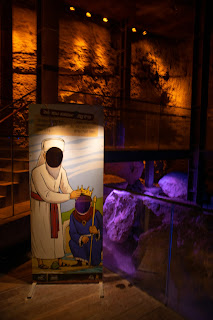Back in March, I went with a friend to the Galilee. It was almost time for Shabbat to start as we parked near the lake and scrambled up the hill to this overlook that is marked only by a simple stone with a cross carved into it.
On the map, this observation point on the north end of the Sea of Galilee is just a dot with a name: Ein Nur. I'd never heard of it until last February, when I discovered the Israeli youtubers Sergio and Rhoda and watched their video on this place. You can watch it here:Sunday, May 29, 2022
An alternate site for the Sermon on the Mount?
Sunday, May 22, 2022
The Red-Haired Archaeologist Digs Israel
Right before coming to Israel, I found this short, quick read by Amanda Hope Haley: The Red-Haired Archeologist Digs Israel.
Sunday, May 15, 2022
City of David: ancient Jerusalem's walls and Pool of Siloam
Here we are–about to visit the Pool of Siloam!
As I stated last week, the ancient Hezekiah's Tunnel leads directly into the Pool. I actually don't know where modern tourists will exit from it now, but you can see the exit at the pool. Because I took the dry Canaanite tunnel, I was able to walk and see more outside, including:
THE ANCIENT CITY WALLS!!!!!
Sunday, May 8, 2022
City of David: Hezekiah's Tunnel (Part 1)
Back in the City of David, it's time to see Hezekiah's Tunnel!
I don't have many pictures from this part of the tour, because as I said in the last post, I was so in shock over all I'd seen already that I forgot to take my polarizing filter off my lens—and everything was blurry. (The picture above is actually from the end of the tunnel, outside). I was aware of the blurry photos, so I snapped a few with my phone. This is the entrance from inside.WOW! Incredible! I actually knew a lot about Hezekiah's Tunnel before seeing it, thanks to Lynn Austin's incredible research in the Chronicles of the Kings series, which I highly recommend!
Finally, on the way back from the Jerusalem the day I first toured the City of David, I saw this article from All Israel News:
Turkey currently has a stone from 700 BC with an inscription that confirms how this tunnel was dug. It is one of the oldest known artifacts written in Hebrew, and it says:
“… this is the story of the tunnel, while [the hewers lifted] their axes toward their counterparts, and while three cubits more were to (be hewn?), was heard the voice of a man calling to his counterpart, (for) there was [a crack?] in the rock, on the right and on the left. And on the day of [the final barrier’s] piercing, the stonecutters struck each man towards his counterpart, ax against ax and water flowed from the source to the pool for 1,200 cubits and 100 cubits was the height of the rock, over the head of the stonecutters …”
Wow! This stone was discovered while the Ottomans still ruled Jerusalem, and they took it back to Turkey. At the time of the writing of this article, Turkey hadn't confirmed this officially. But how cool- that this story came out the first time I ever saw Hezekiah's tunnel!
See you next week for the final stop (for now) in my visit to the City of David: the Pool of Siloam!
Sunday, May 1, 2022
City of David: David's Palace and the Gihon Spring
This week is part 1 of a 3 part series on the City of David. This site was so incredible that I lost my mind approximately 6 times. I can't wait to go back when it's warmer and get a full tour, complete with Hezekiah's tunnel (spoiler alert).
I have tried to get to the City of David for a while now, but it was hard with my schedule whenever I was in Jerusalem over the weekends (because the different sabbaths for the different faiths mean not everything is open). Even this time, I wasn't fully sure what we were going to see. That's why this was such an incredible surprise!
We left the Western wall, exited onto the main road, and turned left towards the Mount of Olives. On the way in, you can see more excavations in progress!







































